Like many, if not all, football fans, we at Total Football Analysis are big admirers of clubs bringing young players through the ranks and into the first team.
Even those players who were brought to the club at around 17-18 years of age—seeing them develop and blossom into (potential) first-team players is one of the best things in the game.
One position that arguably needs some injection of fresh faces to burst onto the scene is full/wing-back.
That’s not to say that there aren’t any elite players in those positions, but when you scope the market, the depth of high-quality players isn’t the same as, say, wingers.
That said, you can find some up-and-coming prospects at full-back and wing-back playing all around the globe, but Serie A seem to be one of the current leaders in that market.
Now, unless you’re familiar with Serie A, you may not have much insight into the youngsters we are referring to—but one example would be Leicester City left-back Victor Kristiansen.
The Danish left-back excelled in his loan spell at Bologna last campaign, helping them qualify for the UEFA Champions League.
In this data analysis, we will explore the data of 15 U21 full-backs and wing-backs who will be with Serie A clubs for the 2024/25 season (at the time of writing) and could well make first-team contributions.
The Serie A analysis will investigate various statistics within three key areas – defensive data, ball progression data, and attacking data: viewing that range of statistics will allow us to formulate ideas on who we can expect to have a strong future and/or breakthrough into the first team picture.
Criteria
To meet the primary focus of this data analysis (highlighting the best young full-backs/wing-backs in Serie A), we have avoided utilising strict criteria for player selection.
Those involved in this analysis will have played a minimum of 180 minutes of football across first-team and/or academy football for the team they were with in the 2023/24 campaign.
This does mean that the data of some players in this analysis will primarily be from their time in their respective club’s academy side last season—to highlight the most likely to feature for the first team this season, we have selected players who made at least one appearance for the first team last season.
We have also included players who meet the above criteria but will be playing in Serie B this season after their club was relegated from Serie A.
The aim is to highlight players who featured in a first-team setting and could potentially be involved in a promotion race this season.
Defending
While the role of a modern full/wing-back often appears to have more focus on the attacking aspects of the game, the defensive side of the game is still essentially the bedrock of playing in that position.
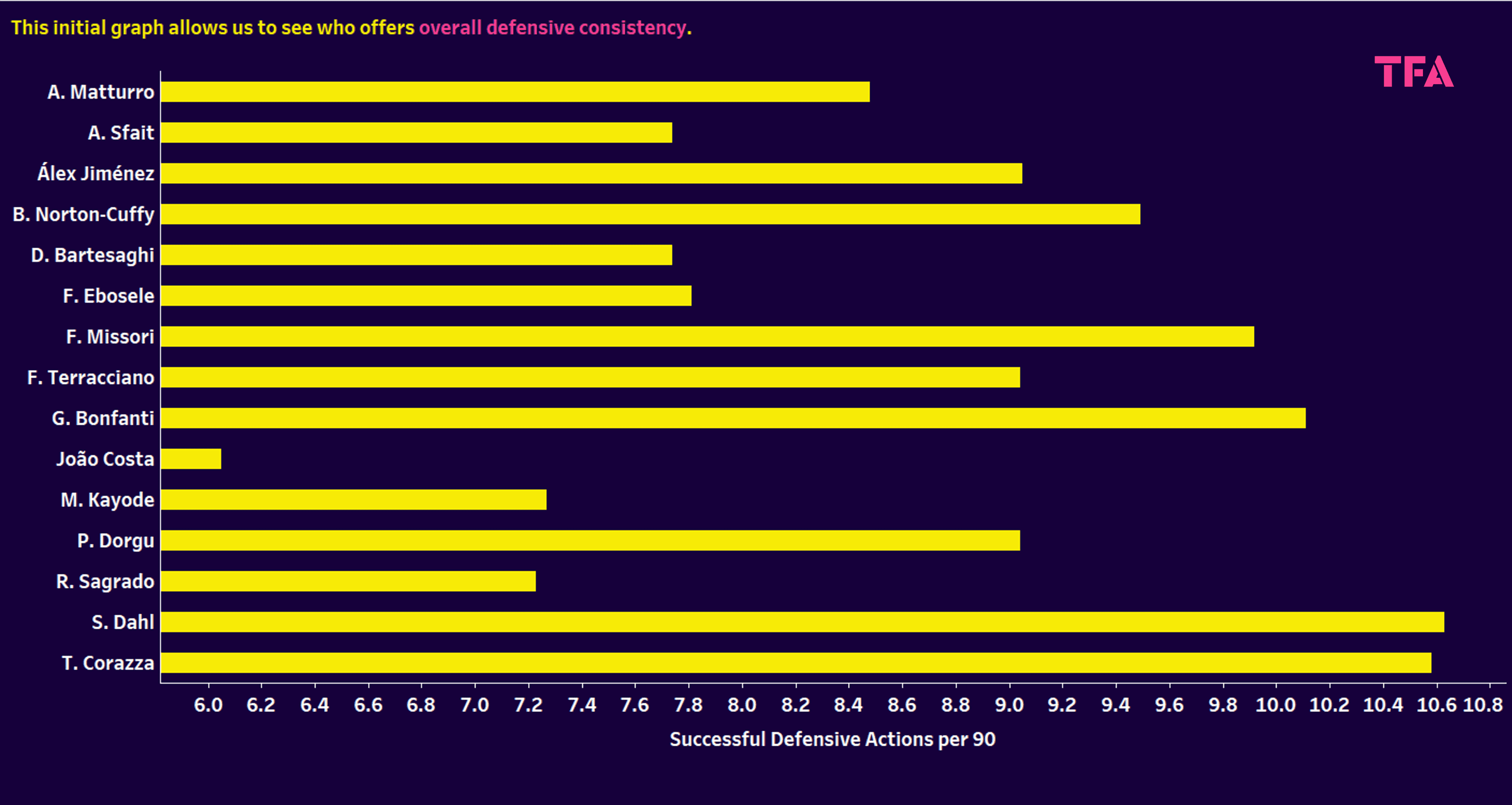
We begin by giving ourselves a view of each player’s contributions in terms of defensive application.
The graph above shows us the average number of successful defensive actions made per 90 minutes, with a few names standing out.
It is important to note that while Roma youngster João Costa may seem to offer a lower defensive contribution, he does primarily play as a winger for Roma’s U19 team.
However, he can and has been used as a wing-back for the first team; hence, his involvement.
On the other end of the scale, players such as Filipo Missori (Sassuolo, 9.92 successful defensive actions per 90), Giovanni Bonfanti (Pisa, 10.11), Samuel Dahl (Roma, 10.63), and Tomasso Corazza (Bologna, 10.58) all offer consistent positive results in terms of defensive actions.
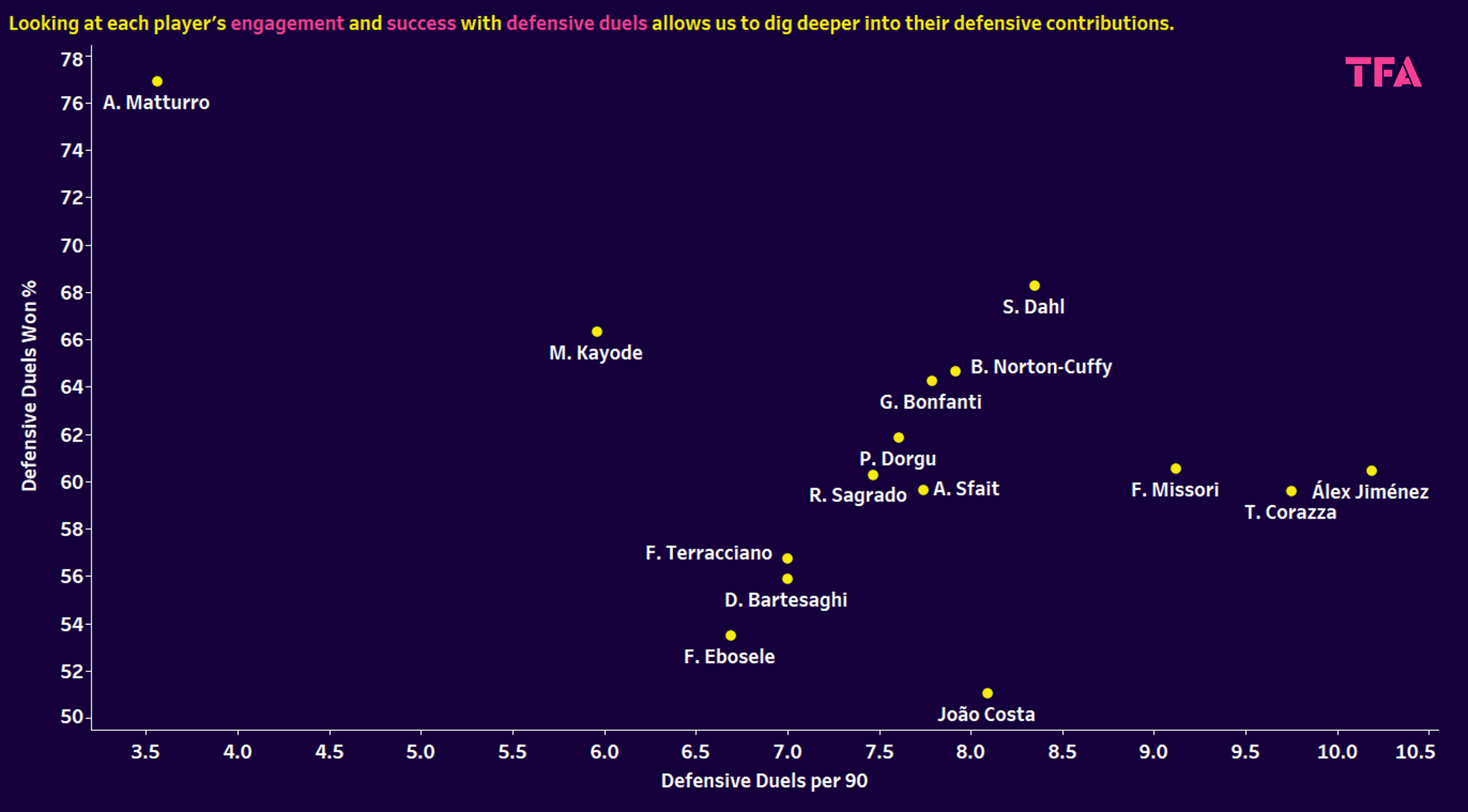
Taking a look at the engagement and success levels for defensive duels allows for a better understanding of a player’s defensive quality than simply looking at total actions – the graph above shows those statistics.
Interestingly, Genoa’s Alan Matturro has a low engagement level of just 3.56 defensive duels per 90 but offers an impressive success rate of 76.92% – the highest of any player involved in this analysis.
Matturro can also play as a central defender, which could impact his involvement in terms of defensive duels, depending on his role within Bologna’s tactics.
AC Milan’s Álex Jiménez offers the highest average of the group when it comes to defensive duels per 90 (10.19) and brings a decent success rate of 60.45% – that percentage may increase if his role adjusts into a slightly more reserved one where he makes slightly fewer duel attempts.
Corazza and Missori are in similar boats.
If you want a player who ticks both boxes in terms of engagement and results, Dahl could be the answer – his 8.35 duels per 90 is an indication of defensive confidence, while his strong success rate of 68.26% suggests he can back that confidence up.
Those impressive numbers were posted in Sweden’s top tier for Djurgården prior to his switch to Italian football this summer.
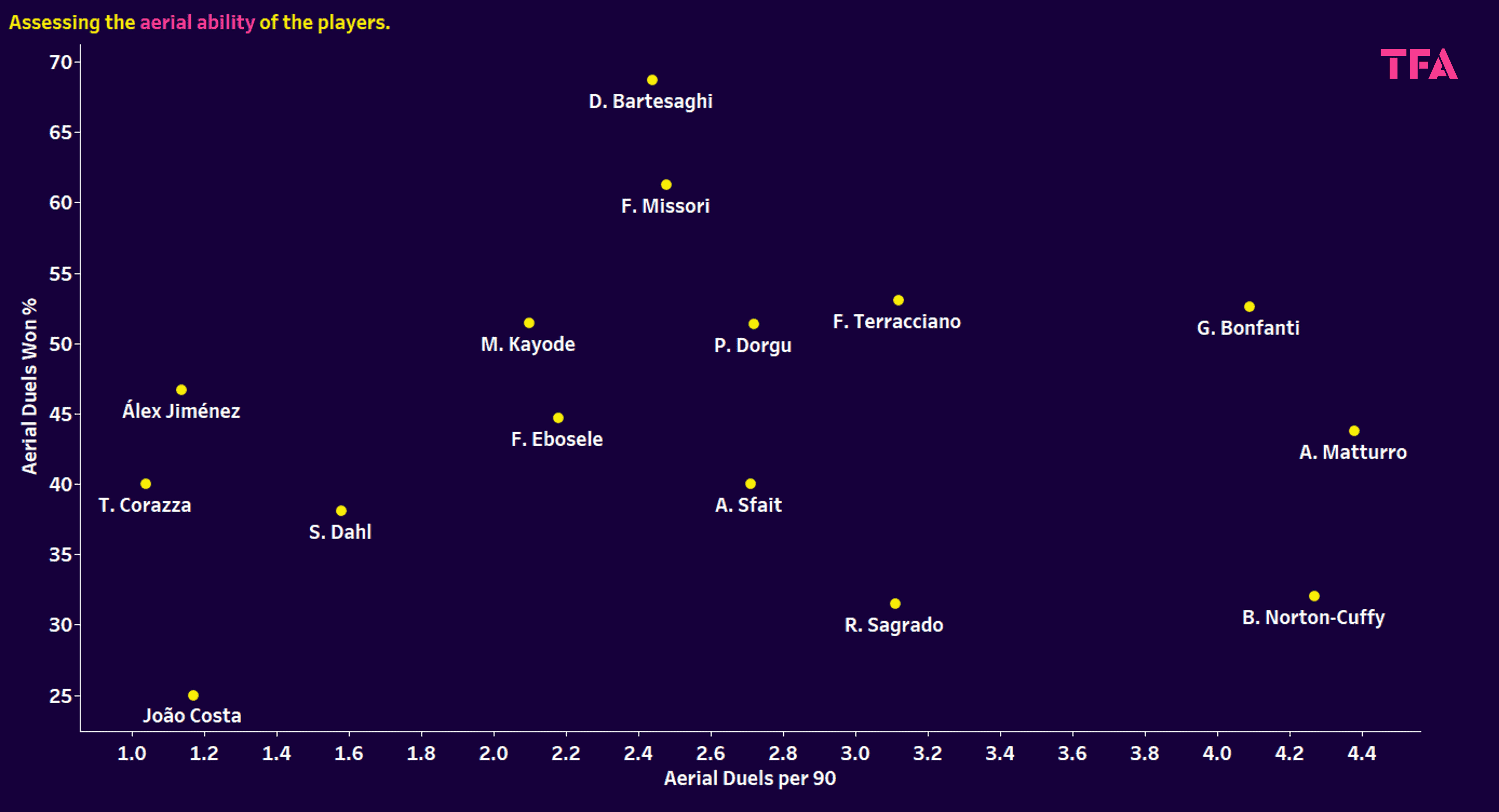
Aerial duels aren’t as important for wide defenders as they are for central defenders, but nevertheless, they are a vital trait.
A player’s role could impact their engagement in the air – a player who plays as a high wing-back is less likely to have a high aerial engagement than a player who operates as a more defensive full-back, for example; something to consider.
Matturro offers good engagement paired with positive results—perhaps to be expected from a 6’2” defender who is primarily a centre-back.
Missori and Milan’s Davide Bartesaghi are two players who show promise in terms of aerial ability, with the latter also being able to do as a centre-back.
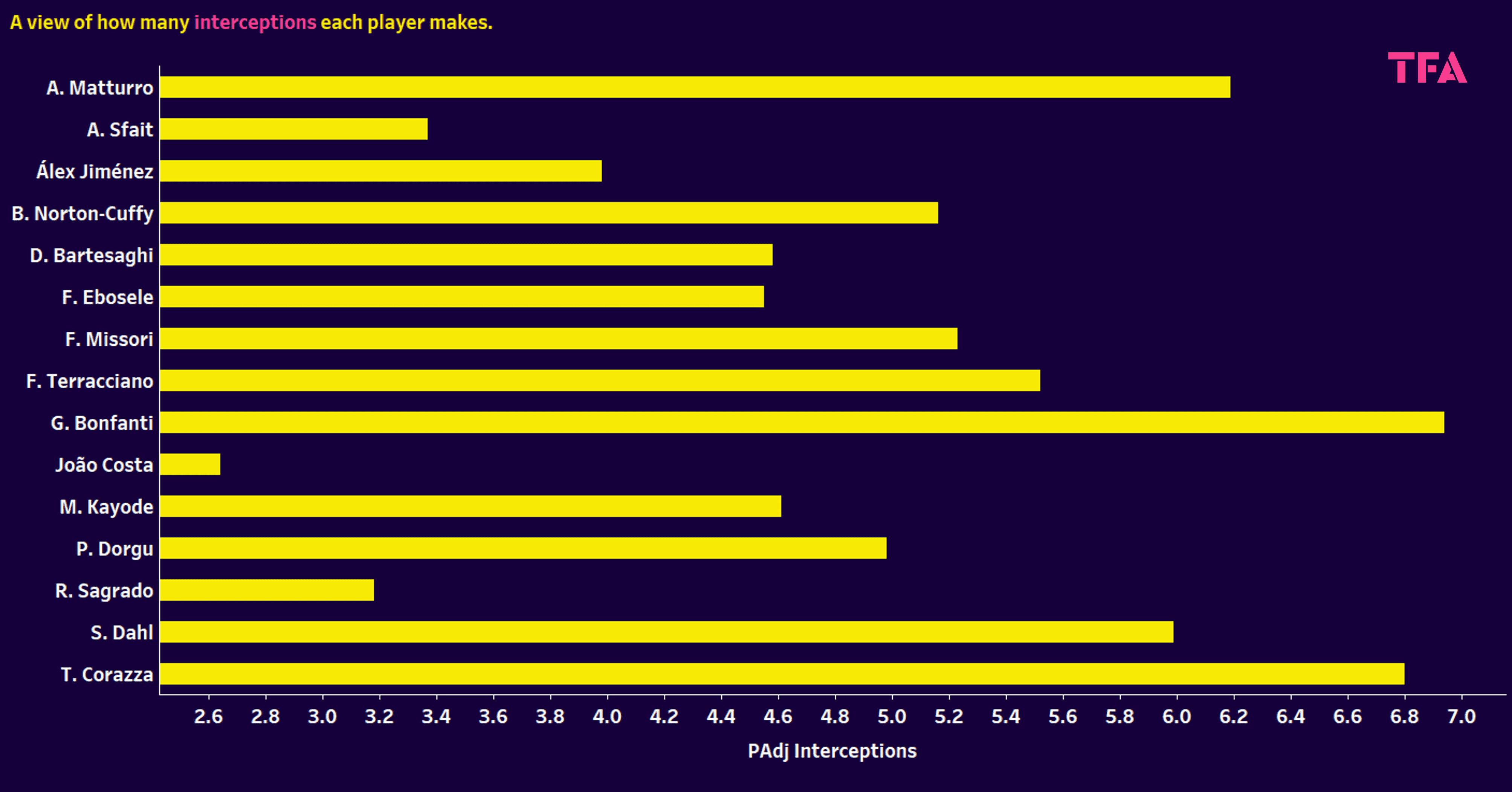
We end the defensive segment of this analysis by examining the players’ ability to break up opposition play through interceptions.
Three names we have already seen a fair bit of: Matturro (6.19 per 90), Bonfanti (4.79), and Corazza (6.80) lead the way.
The first two, as mentioned, can also play as centre-backs, which obviously plays a part in their high engagement for interceptions.
The latter, however, has only played as a full-back/wing-back, so that is a real indication of a good ability to read situations within a game.
Ball Progression
Wing-backs and full-backs are often vital in a team’s attacking tactics, either providing extra width high up the pitch or being an important cog in a possession phase with in midfield.
From dribbling the ball into more advanced positions to being a creative force in an attacking phase, wide defenders today can greatly influence a team’s tactics.
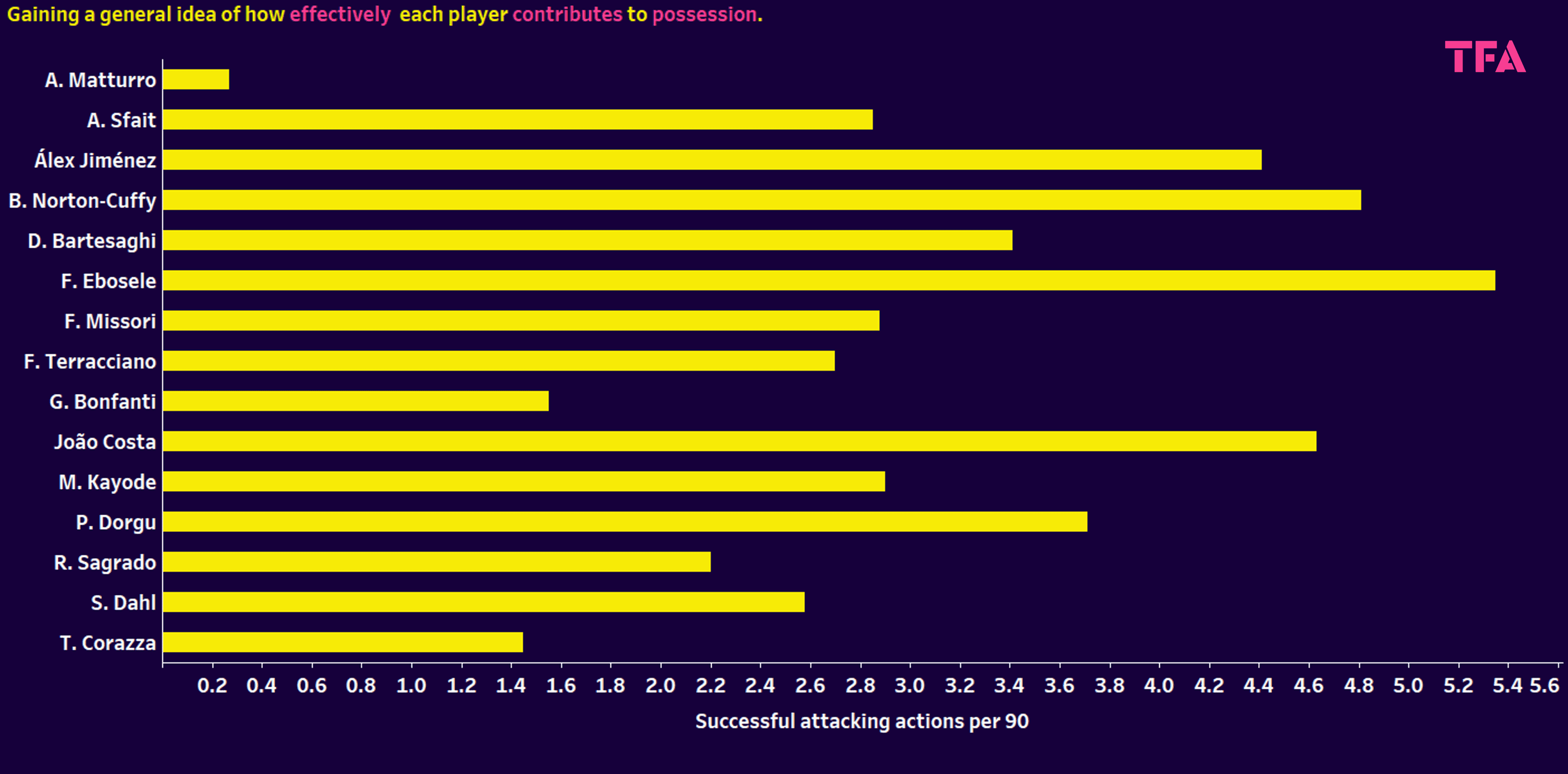
The data above is relevant for this and the next segment as it measures the players’ average output via attacking actions.
This is where we see some of the more aggressive wing-backs come into play more than the defensive full-backs—of course; we mentioned Costa, who has mostly played as a winger up to this point in his career, hence the high number of attacking actions.
Udinese’s Festy Ebosele—interestingly not the only player with EFL Championship experience in this analysis—was an important part of his side’s attacking approach last season, and his 5.35 successful attacking actions per 90 acts are the base evidence.
Another player with EFL Championship history, Brooke Norton-Cuffy, who recently joined Genoa from Arsenal after an impressive loan spell at Millwall last season, offered 4.81 successful attacking actions in 23/24—he, too, can play as a winger as well as an RB/RWB.
Former Real Madrid youngster Jiménez also likes to be a part of his team’s attacking phase, having offered 4.41 successful attacking actions per 90 – most of his football last season was with Milan’s U19 side but did feature for the first team briefly.
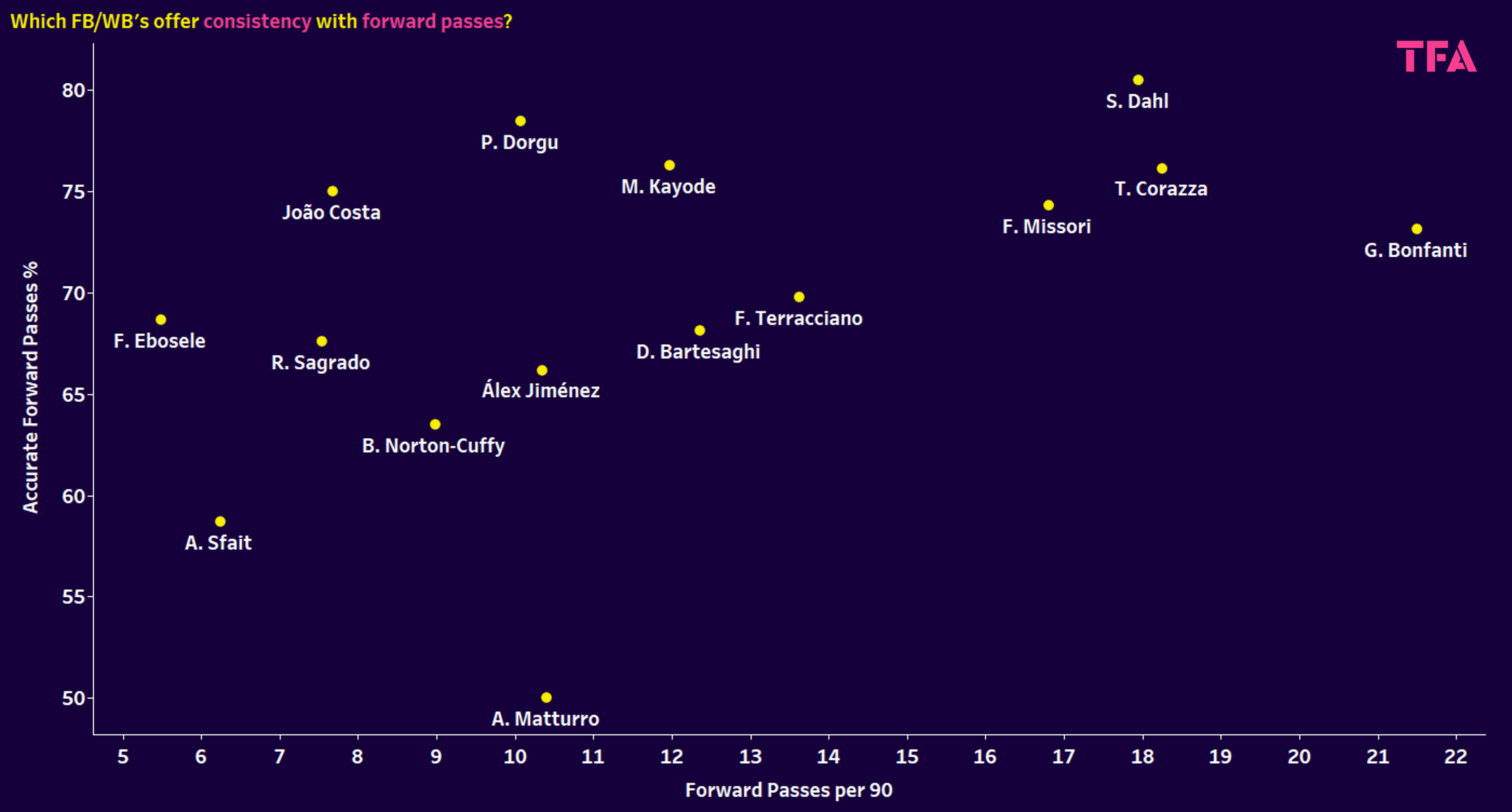
To be an effective attacking player, you must show confidence in your play and be prepared to take risks from time to time, regardless of your position on the pitch.
Making forward passes is such a simple detail, but when carried out consistently, it can define a player’s style and involvement—we see many players who offer little in the way of forward passes and opt for the safe backward pass all too often.
It is important to note here that centre-backs are far more likely to play a higher number of forward passes for obvious reasons.
However, wide defenders like Dahl and Missori have both posted data that suggests confidence and attacking aggression in their play.
The latter, in particular—17.95 forward passes from the left-back position—makes some contribution, and his accuracy rate of 80.5% is even more impressive.
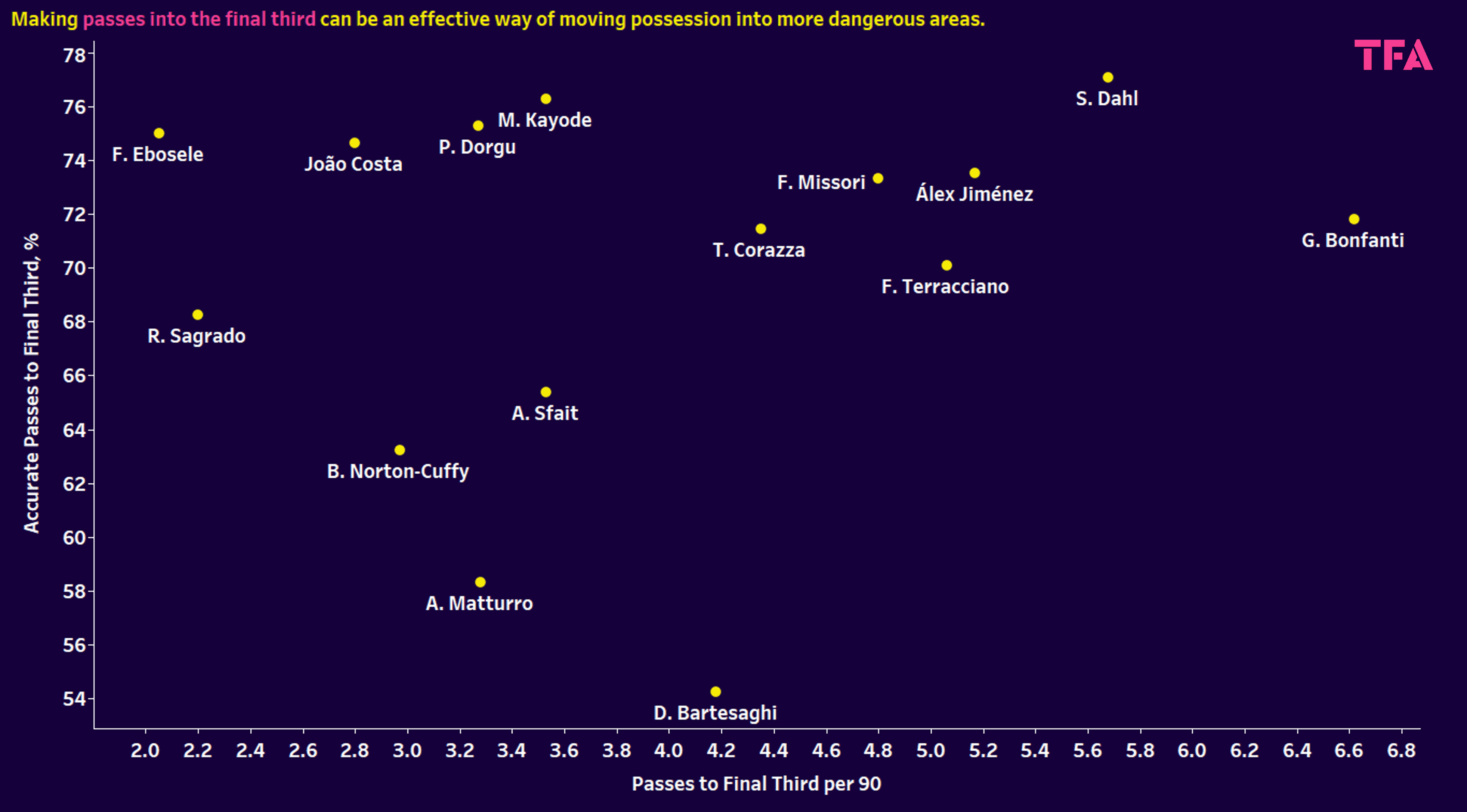
The passes to the final third statistic is similar to the previous one, but this offers more insight into which players are playing bigger parts in the latter stages of an attacking phase.
Once again, Dahl impresses – 5.68 passes into the final third per 90, which shows a consistent attacking presence and impact.
Once more, he posts a high accuracy rate of 77.09%.
Bonfanti, a centre-back who plays in this analysis, is quite engaged in passes into the final third, which is quite an interesting part of his game.
With general forward passes from the centre-back spot, that obviously includes five-yard passes, whereas this data offers insight into true ball progression.
The Pisa defender will be a key part of their Serie B campaign this season, especially if he can replicate his in-possession contributions from last season.
Several other players offer a high accuracy rate with this particular statistic—Missori and Jiménez are particularly impressive in relation to this data set.
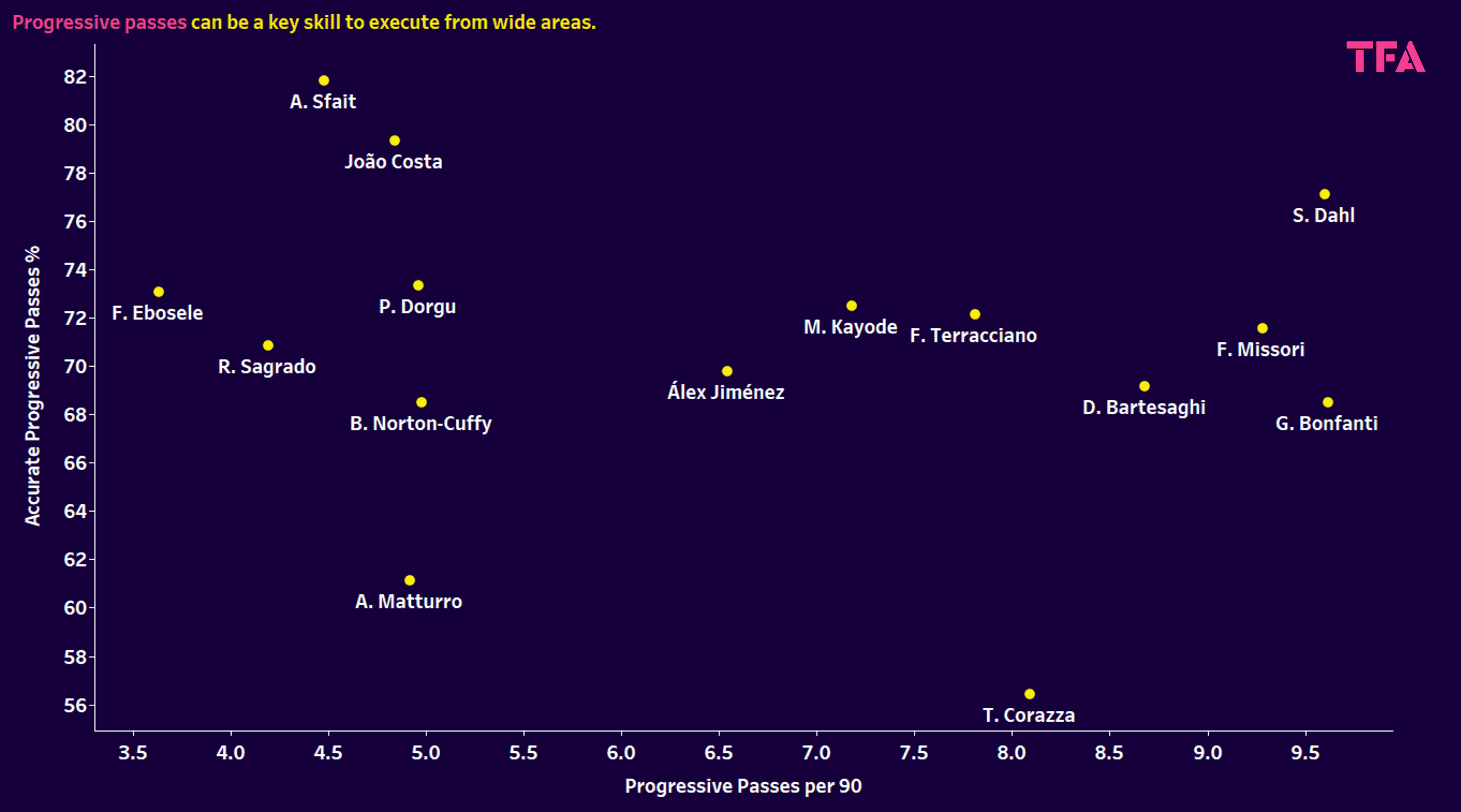
This graph relates to the previous two while also providing insight into which players offer possession progression in terms of passes that are longer in distance.
As expected, some familiar names crop up again—Dahl, Missori, Bonfanti—with the former offering the most impressive data across both metrics in the above graph.
One player who we haven’t yet mentioned, but has a huge future ahead of him, is Michael Kayode, of Fiorentina – at just 20 years of age he is already an important part of his club’s plans, and could be a player who brings them a big fee in the next few years.
Kayode shows promise in terms of ball progression—7.18 progressive passes per 90 with a 72.5% completion rate tells us that he has the ability to consistently impact his team’s build-up positively.
Milan youngster Filippo Terracciano offered similar numbers to Kayode last season while playing for Hellas Verona.
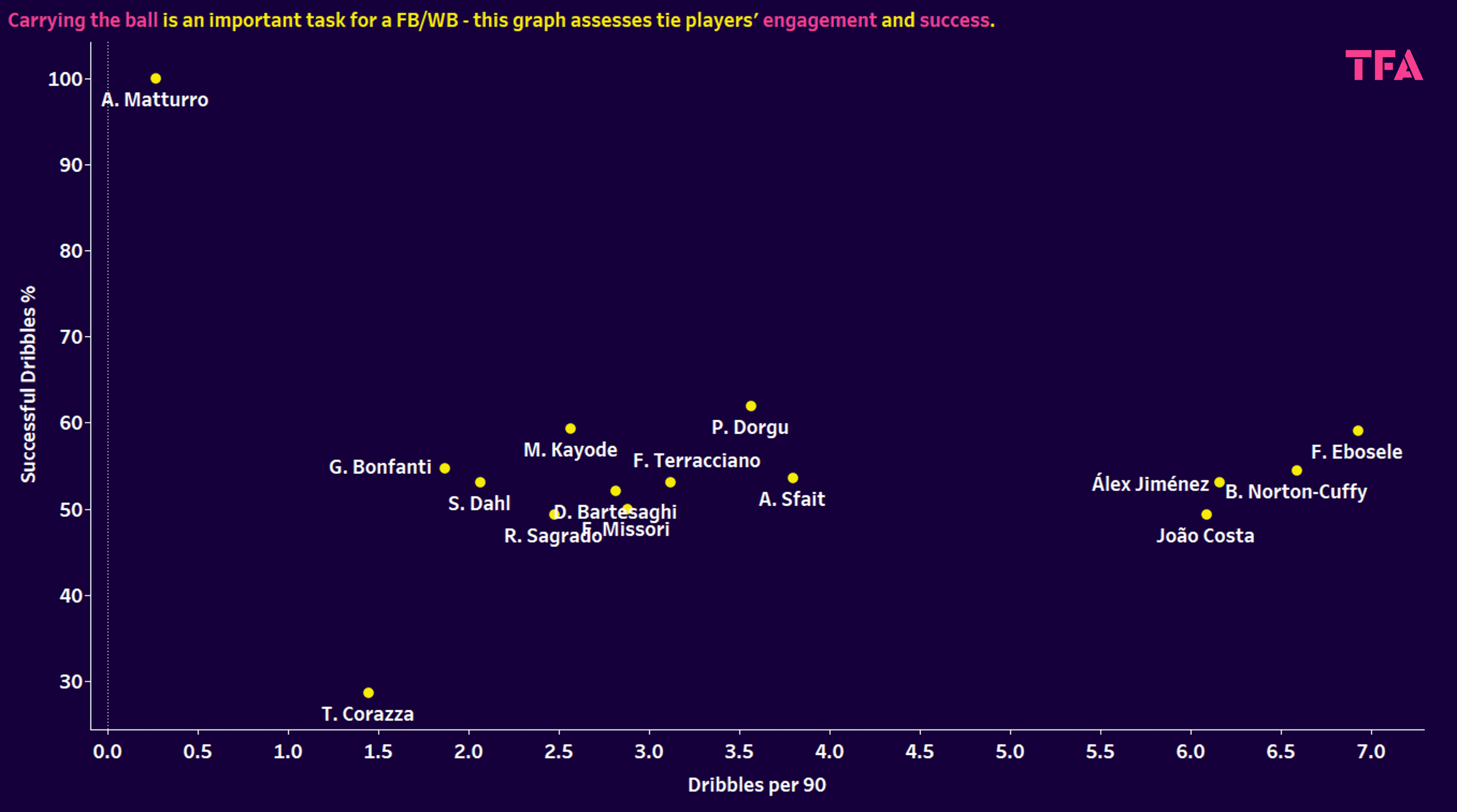
We wrap this segment up by assessing these players’ dribbling ability—dribbling is one of the most important tools an attacking wing-back can have.
Ebosele shows much promise from a technical perspective—his 6.93 dribbles per 90 tells us that he is not afraid to drive possession forward himself, while his success rate of 59.06% suggests that he possesses a high level of technical skill—the ability to beat the opponent and get past them.
Norton-Cuffy, Costa, and Jiménez all offer similar contributions to Ebosele but with slightly lower numbers.
Chance Creation
Many managers like their full/wing-backs to be an important attacking presence.
While they may not expect a huge return in terms of goals scored, assisting goals or just generally creating chances is something that many managers demand from their attacking wide defenders.
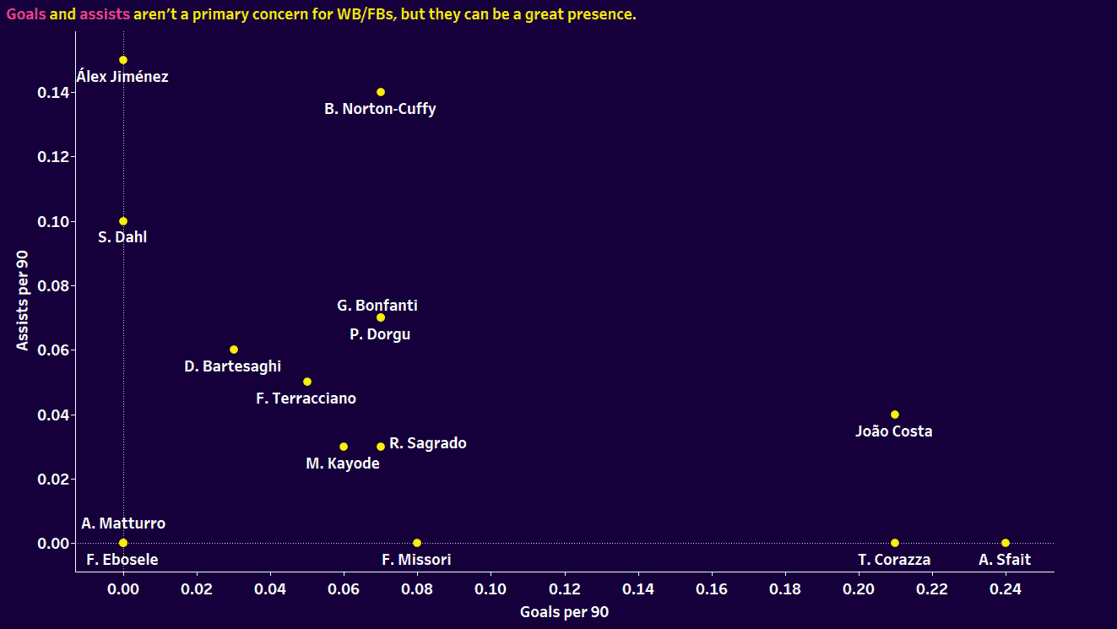
This overview of the players’ G/A contributions tells us little about who has that attacking influence.
Norton-Cuffy and Jiménez both impress by offering at least 0.14 assists per 90, while the latter of the two also offers a minor direct goal threat.
Roma’s Dahl appears again thanks to his 0.1 assists per 90, another hint at his creative ability.
Meanwhile, Ebosele will be hoping that G/A is something he can add to his game this season after being absent in that area in the 23/24 campaign.
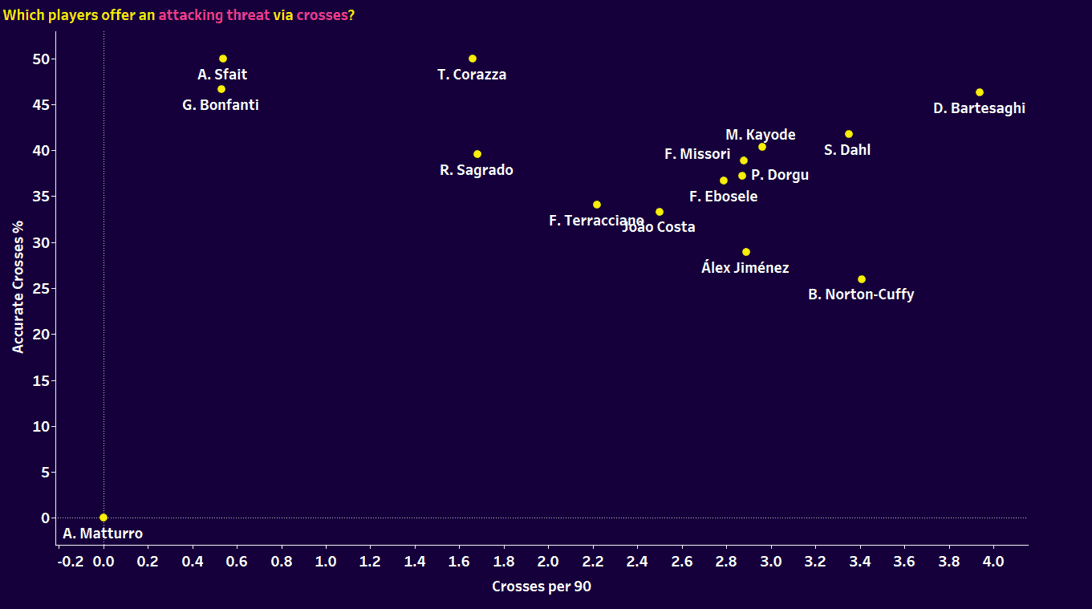
As you may expect, crosses are another vital tool for wide defenders to possess.
Whether it’s delivering the ball into the box from deep areas, or getting toward the byline before putting the ball into the mixer, crossing is one of the most effective and common ways for a wing/full-back to create chances on goal.
Bartesaghi’s name instantly stands out due to his high engagement (3.94 crosses per 90) and good accuracy rate of 46.27%.
If he can bring that quality into the first-team setting, Milan may be able to add a whole new dimension to their attack.
Kayode and Dahl impress yet again, while Corazza shows incredible promise with his 50% accuracy rate, although his engagement is lower than desired.
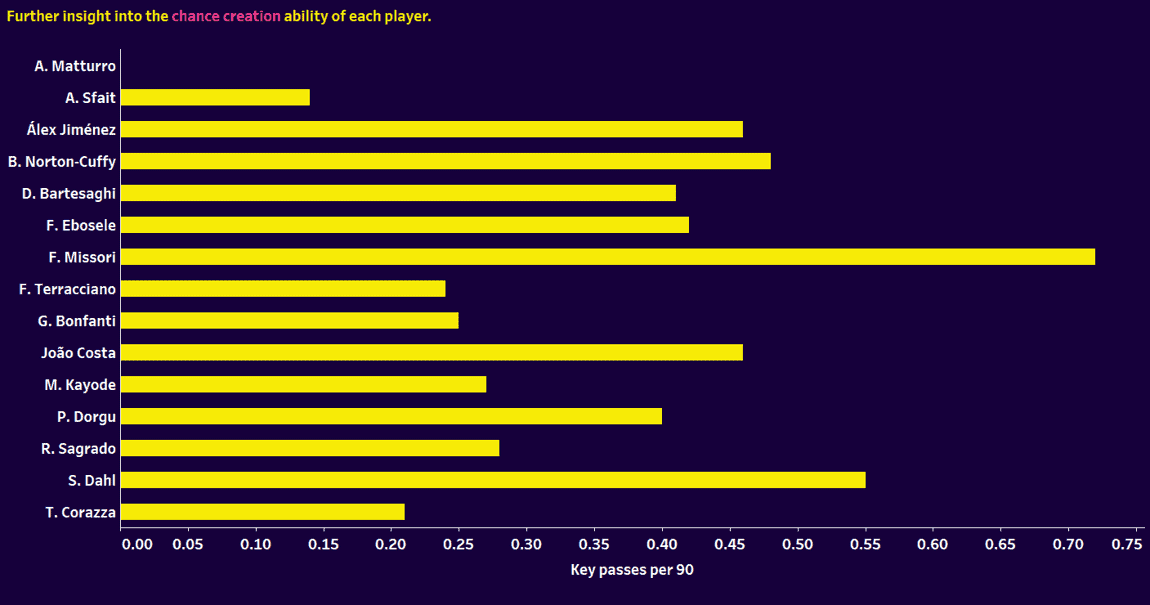
We end this segment and the overall data analysis section by examining how many key passes each player makes.
A key pass is defined as a pass that instantly creates a goalscoring opportunity.
Missori and, you guessed it, Dahl impress once more, with the former contributing an impressive 0.72 key passes per 90 last season in a struggling Sassuolo side – and as you can see, nobody in this analysis gets close to that number.
Costa, Jiménez, Patrick Dorgu (Lecce), Ebosele, Norton-Cuffy, and Bartesaghi all also show promise in chance creation, with those names all making at least 0.4 key passes per 90.
Conclusion
While it remains possible that not all of the players involved in this analysis will have a career at the top level, several of them are destined for exactly that—some of them are already established first-teamers.
New Roma signing Samuel Dahl offers a fantastic influence in possession while also offering some strong defensive qualities.
Whether he can make the step from the Swedish Allsvenskan to Serie A will be an interesting tale.
Another player who posted good data in several areas is Filippo Missori.
The 20-year-old could be a key figure in Sassuolo’s bid for an immediate return to the top flight this season.
His well-rounded attribute set could be something Sassuolo can lean on—his defensive acumen and creative ability will be key.
Brooke Norton-Cuffy will hope to make a swift impact after moving to Genoa, gaining vital experience in a tough Championship division last season.
He will be looking to transfer that to Italy’s top flight as soon as possible.
Other notable players from this analysis include Michael Kayode, Festy Ebosele, Álex Jiménez, and Tomasso Corazza, but of course, all 15 players in this data analysis have the potential to be established top-flight players, or maybe even more.






Comments